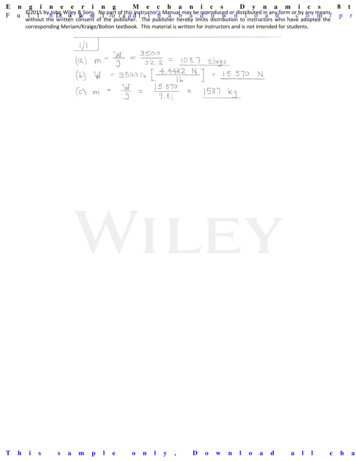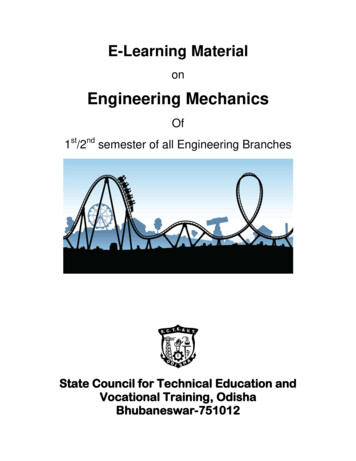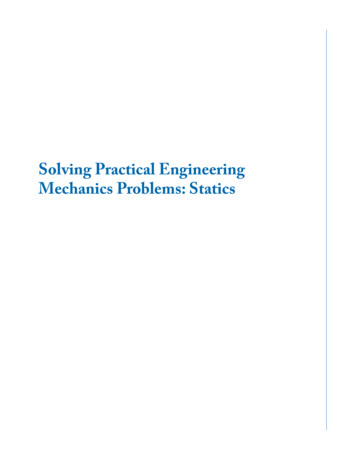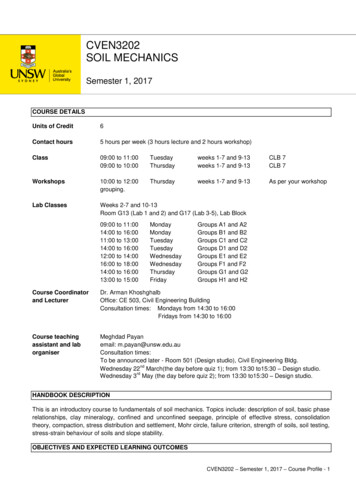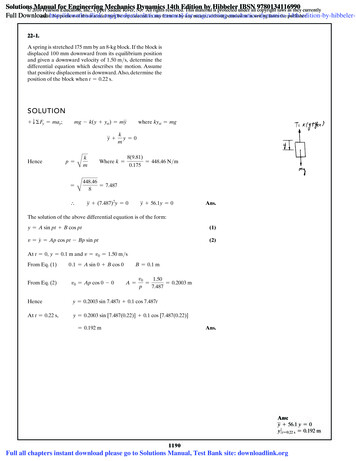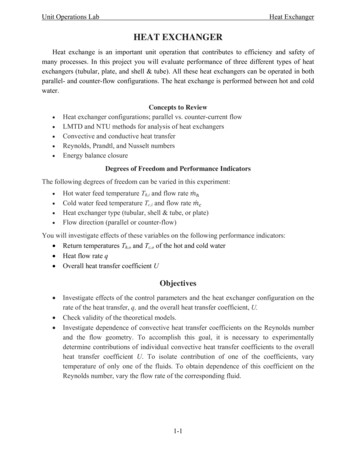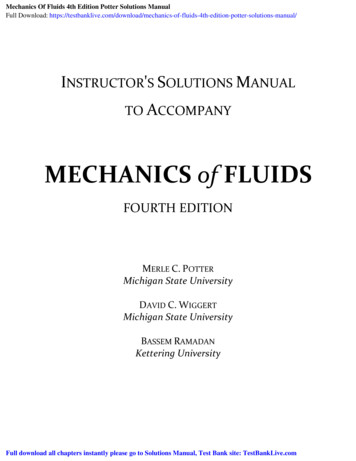
Transcription
Mechanics Of Fluids 4th Edition Potter Solutions ManualFull Download: 'S SOLUTIONS MANUALTO ACCOMPANYMECHANICS of FLUIDSFOURTH EDITIONMERLE C. POTTERMichigan State UniversityDAVID C. WIGGERTMichigan State UniversityBASSEM RAMADANKettering UniversityFull download all chapters instantly please go to Solutions Manual, Test Bank site: TestBankLive.com
ContentsChapter 1Basic Considerations1Chapter 2Fluid Statics15Chapter 3Introduction to Fluids in Motion43Chapter 4The Integral Forms of the Fundamental Laws61Chapter 5The Differential Forms of the Fundamental Laws107Chapter 6Dimensional Analysis and Similitude125Chapter 7Internal Flows145Chapter 8External Flows193Chapter 9Compressible Flow237Chapter 10Flow in Open Channels259Chapter 11Flows in Piping Systems303Chapter 12Turbomachinery345Chapter 13Measurements in Fluid Mechanics369Chapter 14Computational Fluid Dynamics375
Chapter 1/ Basic ConsiderationsCHAPTER 1Basic ConsiderationsFE-type Exam Review Problems: Problems 1-1 to 1-14.1.1(C)m F/a or kg N/m/s2 N.s2/m.1.2(B)[μ1.3(A)2.36 101.4(C)The mass is the same on earth and the moon:1.5(C)Fshear1.6(B)1.7(D)1.8(A)1.9(D)[τ du/dy] (F/L2)/(L/T)/L F.T/L2.8F sinF shearA1000waterdudrh23.6 104 cosgD923.6 nPa.4200sin 302100 N250 10(T 4)21804mdudr[4(8r )] 32 r.2100 N.84 103 Pa or 84 kPa2(80 4)21801000[10 5000r ] 103968 kg/m310 5000 0.02 1 Pa.4 0.0736 N/m 11000 kg/m3 9.81 m/s2 10 106m3 m or 300 cm.We used kg N·s2/m1.101.11(C)(C)mpVRT800 kN/m 2 4 m30.1886 kJ/(kg K) (10 273) K159.95 kg 2012 Cengage Learning. All Rights Reserved. May not be scanned, copied or duplicated, or posted to a publicly accessible website, in whole or in part.
Chapter 1 / Basic Considerations1.12(B)EiceEwater . mice 320 mwater cwater T .5 (40 10 6 ) 1000 320 (2 10 3 ) 1000 4.18 T .T 7.66 C.We assumed the density of ice to be equal to that of water, namely 1000 kg/m3.Ice is actually slightly lighter than water, but it is not necessary for such accuracyin this problem.1.13(D)For this high-frequency wave, cRT287 323 304 m/s.Chapter 1 Problems: Dimensions, Units, and Physical Quantities1.14Conservation of mass — Mass — densityNewton’s second law — Momentum — velocityThe first law of thermodynamics — internal energy — temperature1.15a) density mass/volume M / L3b) pressure force/area F / L2 ML / T 2 L2 M / LT 2c) power force velocity F L / T ML / T 2 L / Td) energy force distance ML / T 2 L ML2 / T 2e) mass flux ρAV M/L3 L2 L/T M/Tf) flow rate AV L2 L/T L3/T1.16M FT 2 / La) density 3LL3b) pressure F/L2ML2 / T 3FT 2 / L4c) power F velocity FL/T FL/Td) energy F L FLM FT 2 / Le) mass flux FT / LTTf) flow rate AV L2 L/T L3/T1.17a) L [C] T2.[C] L/T2b) F [C]M.[C] F/M ML/T2 M L/T2c) L3/T [C] L2 L2/3.[C] L3 / T L2 L2 / 3 L1/3 TNote: the slope S0 has no dimensions.1.18a) m [C] s2.b) N [C] kg.c) m3/s [C] m2 m2/3.[C] m/s2[C] N/kg kg m/s2 kg m/s2[C] m3/s m2 m2/3 m1/3/s2 2012 Cengage Learning. All Rights Reserved. May not be scanned, copied or duplicated, or posted to a publicly accessible we bsite, in whole or in part.
Chapter 1/ Basic Considerations1.19a) pressure: N/m2 kg m/s2/m2 kg/m s2b) energy: N m kgm/s2m kg m2/s2c) power: N m/s kg m2/s3kg m1s 2 kg / m sd) viscosity: N s/m2 2smN m kg m mkg m 2 / s 3e) heat flux: J/s 2sssJN m kg m mm 2 / K s2f) specific heat:2kg K kg Kskg K1.20kgms2mkm f . Since all terms must have the same dimensions (units) we require:s[c] kg/s, [k] kg/s2 N s 2 / m s 2 N / m, [f] kg m / s 2 N.cNote: we could express the units on c as [c] kg / s1.21a) 250 kNe) 1.2 cm21.22a) 1.25 108 Nd) 5.6m31.231.240.225b) 572 GPaf) 76 mm32 20.738N s/md) 17.6 cm3c) 42 nPab) 3.21 10 5 se) 5.2 10 2 m20.06854mN s2 / m sc) 6.7 108 Paf) 7.8 109 m3m0.00194 3.281 dd2where m is in slugs, in slug/ft3 and d in feet. We used the conversions in the front cover.20/1005.555 10 5 m/s3600b) 2000 rev/min 2000 2 /60 209.4 rad/sc) 50 Hp 50 745.7 37 285 Wd) 100 ft3/min 100 0.02832/60 0.0472 m3/se) 2000 kN/cm2 2 106 N/cm2 1002 cm2/m2 2 1010 N/m2f) 4 slug/min 4 14.59/60 0.9727 kg/sg) 500 g/L 500 10 3 kg/10 m500 kg/m3h) 500 kWh 500 1000 3600 1.8 109 Ja) 20 cm/hr 1.25a) F ma 10 40 400 N.b) F W ma.c) F W sin 30 ma.1.26The mass is the same on the earth and the moon:601.863.m Wmoon 1.863 5.4 10.06 lb32.2F 10F 1040 10 9.81 498.1 N.40 9.81 0.5 449 N.3 2012 Cengage Learning. All Rights Reserved. May not be scanned, copied or duplicated, or posted to a publicly accessible website, in whole or in part.
Chapter 1 / Basic 2250.2250.2254.8 10260.184 (3.7 104.8 10)260.00103 (3.7 104.8 100.43 10 6 m or 0.00043 mm10 210 27.7 10 5 m or 0.077 mm10 20.0039 m or 3.9 mm)260.00002 (3.7 10)Pressure and Temperature1.28Use the values from Table B.3 in the Appendix.a) 52.3 101.3 153.6 kPa.b) 52.3 89.85 142.2 kPa.c) 52.3 54.4 106.7 kPa (use a straight-line interpolation).d) 52.3 26.49 78.8 kPa.e) 52.3 1.196 53.5 kPa.1.29a) 101c) 14.7e) 301.301.311.3231 70 kPa abs.b) 7603114.7 10.2 psia.d) 341013130 20.8 in. of Hg abs.10131760 527 mm of Hg abs.1013134 23.6 ft of H2O abs.101p po e gz/RT 101 e 9.81 4000/287 (15 273) 62.8 kPaFrom Table B.3, at 4000 m: p 61.6 kPa. The percent error is62.8 61.6% error 100 1.95 %.61.622,560 20,000(785 973) 877 psf25,000 20,00022,560 20,000T 12.3 ( 30.1 12.3) 21.4 F25,000 20,0000.512b) p 973 0.512 (785 973) ( .488) (628 2 785 973) 873 psf20.512T 12.3 0.512 ( 30.1 12.3) ( .488) ( 48 2 30.1 12.3) 21.4 F2Note: The results in (b) are more accurate than the results in (a). When we use a linearinterpolation, we lose significant digits in the result.a) p 973 T 48 33,00035,00030,000( 65.8 48) 59 F or ( 5930,000432)5 50.6 C9 2012 Cengage Learning. All Rights Reserved. May not be scanned, copied or duplicated, or posted to a publicly accessible we bsite, in whole or in part.
Chapter 1/ Basic Considerations1.331.34p FnFt26.5 cos 42Fn 1296 MN/m2 1296 MPa.4A152 10(120 000) 0.2 1020 0.2 10442.4 N0.0004 NFn2F tan1Ft2 2.400 N.0.0004 0.00952.4Density and Specific WeightmV0.2 1.92 slug/ft3.180 / 17281.35 1.36 1000 (T 4)2/180 1000 (70 4)2/180 976 kg/m3 9800 (T 4)2/18 9800 (70 4)2/180 9560 N/m3976 978% error for 100 .20%9789560 978 9.81% error for 100 .36%978 9.811.37S 13.61.38Wa) m g32.2 61.8 lb/ft3.0.0024T 13.6 0.0024 50 13.48.13.48 13.6% error 100 .88%13.6Vg12 400 500 109.8112 400 500 10b) m 9.7712 400 500 10c) m 9.831.39 g 1.92S m/ Vwaterwater66. 1.26 0.632 kg 0.635 kg 0.631 kg10/ V.1.94V 4.30 ft35 2012 Cengage Learning. All Rights Reserved. May not be scanned, copied or duplicated, or posted to a publicly accessible website, in whole or in part.
Chapter 1 / Basic ConsiderationsViscosity1.40Assume carbon dioxide is an ideal gas at the given conditions, then200 kN/m30.189 kJ/kg K 90 273 KpRTWVmgV2.915 kg/m32.915 kg/m3 9.81 m/s2gFrom Fig. B.1 at 90 C,28.6 kg/m2 s228.6 N/m32 10 5 N s/m2 , so that the kinematic viscosity is2 10 5 N s/m22.915 kg/m36.861 10 6 m2 /sThe kinematic viscosity cannot be read from Fig. B.2; the pressure is not 100 kPa.1.41At equilibrium the weight of the piston is balanced by the resistive force in the oil due towall shear stress. This is represented byWpistonDLwhere D is the diameter of the piston and L is the piston length. Since the gap betweenthe piston and cylinder is small, assume a linear velocity distribution in the oil due to thepiston motion. That is, the shear stress isVpiston 0VrUsing WpistonDcylinderDpiston / 2mpiston g , we can writeVpistonmpiston gDcylinderDpiston / 2DLSolve Vpiston :Vpistonmpiston g Dcylinder2DpistonDL0.350 kg 9.81 m/s2 0.1205 0.120 m22 0.025 N s/m20.12 0.10 m0.91 kg m2 /N s30.91 m/swhere we used N kg·m/s2.6 2012 Cengage Learning. All Rights Reserved. May not be scanned, copied or duplicated, or posted to a publicly accessible we bsite, in whole or in part.
Chapter 1/ Basic Considerations1.42du /dy . From the given velocityThe shear stress can be calculated usingdistribution,120(0.05 2 y )1.308 10 3 N s/m2 so, at the lower plate where y 0,From Table B.1 at 10 C,dudydudyy2 )u ( y ) 120(0.05 y120(0.05 0) 6 s 11.308 10 36 7.848 10 3 N/m2y 0At the upper plate where y 0.05 m,dudy1.431.44120(0.05 2 0.05)2r 0.25r 0.51.45T force 30(2 1/12)(1/12)dudr30(2 1/12)(1/12)7.848 10 3 N/m2y 0.05du 1.92dr 16s 32 32[32r / r02 ] 32 r / r02 .11 0.014 lb/ft22100.25 /1003103(0.5 /100) 20.5 /100(0.5 /100) 2moment arm 2 RLT2 R3 L1.46 Use Eq.1.5.8: T hpower 6.4 Pa0.00260.41000 2 R 2 L2R0.41000 212 T55020.5/12 0, 3.2 Pa,du2 R2L drR r 0.012 0.232000 2600.01/120.4R21000 2 R2L. 0.414 N.s/m2.4 0.006 2.74 ft-lb.2.74 209.4 1.04 hp5507 2012 Cengage Learning. All Rights Reserved. May not be scanned, copied or duplicated, or posted to a publicly accessible website, in whole or in part.
Chapter 1 / Basic Considerations1.47Fbelt duA 1.31 10dypower 1.48F V746310(0.60.00215.7 10 0.210 hp746r. Due to the areahdur dA r 2 r dr r.dyAssume a linear velocity soelement shown, dT dFT R22 3r dr hh01.494) 15.7 N.dudy400 2602 0.08/122.36 10R445drr(3/12) 4 9110 5 ft-lb.u.yThe velocity at a radius r is r . The shear stress isThe torque is dT rdA on a differential element. We haveT rdA 0.0802000 260r2 rdx ,0.0002209.4 rad/swhere x is measured along the rotating surface. From the geometry xT 0.080.101.50209.4 x / 220.0002xdx 329 00020.08x 2dx02 r, so that329 000(0.083 ) 56.1 N . m3du cons’t and AeB/T AeBy/K AeCy, thendyduduAeCy cons’t. De Cy.dydyD Cy yFinally, or u(y) E (e Cy 1) where A, B, C, D, E, and K are constants.e0CIf1.51Ae40B/T 2.3340.001 Ae B/2930.000357AeA 2.334B /35310 6 e1776/313 6.8010 6, B 1776.10 4 N.s/m28 2012 Cengage Learning. All Rights Reserved. May not be scanned, copied or duplicated, or posted to a publicly accessible we bsite, in whole or in part.
Chapter 1/ Basic ConsiderationsCompressibility1.52m V . Then dm d V V d . Assume mass to be constant in a volume subjecteddVd.d V V d , orto a pressure increase; then dm 0.V1.53B 1.54Use c 1450 m/s. L c t 1450V pVV2200 MPa.B V VV pB0.62 899 m1.3 136.5 MPa201.55p 1.56a) c327,000 144 /1.93 4670 fpsc) c308,000 144 /1.87 4870 fps1.57V 3.81021004202 10 0.00909 m3 or 9090 cm32200b) c1 0.0076 m3.p B327,000 144 /1.93 4940 fpsVV22700.0076 17.25 MPa1Surface Tension2R2 0.0741104 Pa or 29.6 kPa.1.58p 1.59Use Table B.1:1.60The droplet is assumed to be spherical. The pressure inside the droplet is greater than theoutside pressure of 8000 kPa. The difference is given by Eq. 1.5.13:5 10pHence,6 2.96 0.00504 lb/ft.2rpinsidepinsidep poutsidepoutside 10 kPa4RBubbles: p 4 /R 59.3 kPa4 0.00504 7.74 psf or 0.0538 psi1/(32 12)2 0.025 N/m10 kPa5 10 6 m8000 10 8010 kPaIn order to achieve this high pressure in the droplet, diesel fuel is usually pumped to apressure of about 20 000 kPa before it is injected into the engine.1.61See Example 1.4:h 4 cosgD4 0.0736 0.8661000 9.81 0.000290.130 m. 2012 Cengage Learning. All Rights Reserved. May not be scanned, copied or duplicated, or posted to a publicly accessible website, in whole or in part.
Chapter 1 / Basic Considerations1.62See Example 1.4: h 4 cosgD4 0.032cos1301.94 13.6 32.2 0.8/12 0.00145 ft orL2 cos force down ghtL.1.63force up 1.64Draw a free-body diagram:The force must balance:d2W 2 L orL g4d1.651.660.0174 inh L2 cos.gtLneedle2 L.W8gFrom the free-body diagram in No. 1.47, a force balance yields:d2(0.004)2Isg 2 ?7850 9.81 2 0.0741440.968 0.1482NoEach surface tension force D. There is a force on theoutside and one on the inside of the ring.F 2D neglecting the weight of the ring.1.67DFrom the infinitesimal free-body shown:dxd cosgh x dx.cos d d dx/dhg xdxg xWe assumed small so that the elementthickness is x.dlhh(x)FdWVapor Pressure1.68The absolute pressure is p 80 92 12 kPa. At 50 C water has a vapor pressure of12.2 kPa; so T 50 C is a maximum temperature. The water would “boil” above thistemperature.10 2012 Cengage Learning. All Rights Reserved. May not be scanned, copied or duplicated, or posted to a publicly accessible we bsite, in whole or in part.
Chapter 1/ Basic Considerations1.69The engineer knew that water boils near the vapor pressure. At 82 C the vapor pressurefrom Table B.1 is 50.8 (by interpolation). From Table B.3, the elevation that has apressure of 50.8 kPa is interpolated to be 5500 m.1.70At 40 C the vapor pressure from Table B.1 is 7.4 kPa. This would be the minimumpressure that could be obtained since the water would vaporize below this pressure.1.71The absolute pressure is 14.5 11.5 3.0 psia. If bubbles were observed to form at 3.0psia (this is boiling), the temperature from Table B.1 is interpolated, using vaporpressure, to be 141 F.1.72The inlet pressure to a pump cannot be less than 0 kPa absolute. Assuming atmosphericpressure to be 100 kPa, we havex 16.83 km.10 000 100 600 x.Ideal GaspRT1.731.74in101.30.287 (273 15)pRT1.226 kg/m3. 1.226101.31.226 kg/m3 .0.287 (15 273)out9.81 12.03 N/m3851.19 kg/m3.0.287 248Yes. The heavier air outside enters at the bottom and the lighter air inside exits at the top.A circulation is set up and the air moves from the outside in and the inside out:infiltration. This is the “chimney” effect.pRT1.75750 441716 470pVgRT0.1339 slug/ft 3.mV0.1339 15 2.01 slug.100(10 20 4) 9.81 9333 N.0.287 2931.76W1.77Assume that the steel belts and tire rigidity result in a constant volume so that m1 m2:V1p2V2p1orT2T1m1RT1p1m2 RT2.p2(35 14.7)150 46010 4601167.4 psia or 52.7 psi gage. 2012 Cengage Learning. All Rights Reserved. May not be scanned, copied or duplicated, or posted to a publicly accessible website, in whole or in part.
Chapter 1 / Basic Considerations1.78The pressure holding up the mass is 100 kPa. Hence, using pA W, we have100 000 1 m 9.81.m 10 200 kg.Hence,mpVRT100 4 r 3 / 310 200.0.287 288r 12.6 m or dPE1mV 2 mg ( 10).220 32.2.25.2 m.The First Law1.79KE01mV 2 mg ( 20).201.80W1-2b)KE. a) 200 010c)01.81102202200 cos2040 32.2.15(V f2 102 ).2VfVV25.4 fps.35.9 fps.19.15 m/s.115(V f2 102 ).220sds010V2V2115(V f2 102 ).2sds20200sinVf15.27 m/s.115(V f2 102 ).2115(V f2 102 ).22Vf16.42 m/s.110 402 0.2u1 0 u2 .u2 u1 40 000.240 00055.8 C where cv comes from Table B.4.u cv T.T717The following shows that the units check:E1E2 .mcar V 2mair ckg m2 / s 2m2 kg Cm2 kg Ckg J/(kg C)N m s2(kg m/s2 ) m s 2where we used N kg.m/s2 from Newton’s 2nd law.1.82E2E1.1150021mV 22CmH2Oc T .100 1000360021000 2000 1064180 T .T69.2 C.We used c 4180 J/kg. C from Table B.5. (See Problem 1.75 for a units check.)12 2012 Cengage Learning. All Rights Reserved. May not be scanned, copied or duplicated, or posted to a publicly accessible we bsite, in whole or in part.
Mechanics Of Fluids 4th Edition Potter Solutions ManualFull Download: ids-4th-edition-potter-solutions-manual/Chapter 1/ Basic Considerations1.83m f h f mwater c T . 0.2 40 000 100 4.18 T .T 19.1 C.The specific heat c was found in Table B.5. Note: We used kJ on the left and kJ on theright.1.84pmRTdVV2d V mRTmRT lnmRT ln 2VVV1p1since, for the T const process, p1 V 1 p2 V 2 . Finally,41W1-21716 530ln78,310 ft-lb.32.22Wpd VThe 1st law states:Q W0.u mcv TQ W78,310 ft-lb or101 Btu.1.85If the volume is fixed the reversible work is zero since the boundary does not move. Also,mRT T1 T2since Vthe temperature doubles if the pressure doubles. Hence, using,pp1 p2Table B.4 and Eq. 1.7.17,200 2a) Q mcv T(1.004 0.287)(2 293 293) 999 kJ0.287 293200 2b) Q mcv T(1.004 0.287)(2 373 373) 999 kJ0.287 373200 2c) Q mcv T(1.004 0.287)(2 473 473) 999 kJ0.287 4731.86Wpd Vthen V1.871.88T12V 1 ). If p const,2V 1 and Wa) W 2 0.287b) W 2 0.287c) W 2 0.2872c kRTT2p( Vp(2 V 1 V 1)333 191 kJ423 243 kJ473 272 kJT1V1pV 1T2so if T2V2mRT1.2T1,1.4 287 318 357 m/s. L c t 357 8.32 2970 m.p2p1k 1/ k(20 273)50050000.4 /1.4151.8 K or121.2 CWe assume an isentropic process for the maximum pressure:k /k 11.4 / 0.4T423p2 p1 2(150 100)904 kPa abs or 804 kPa gage.T1293Note: We assumed patm 100 kPa since it was not given. Also, a measured pressure is agage pressure.13 2012 Cengage Learning. All Rights Reserved. May not be scanned, copied or duplicated, or posted to a publicly accessible website, in whole or in part.Full download all chapters instantly please go to Solutions Manual, Test Bank site: TestBankLive.com
Chapter 2 Fluid Statics 15 . Chapter 3 Introduction to Fluids in Motion 43 . Chapter 4 The Integral Forms of the Fundamental Laws 61 . Chapter 5 The Differential Forms of the Fundamental Laws 107 . Chapter 6 Dimensional Analysis and Similitude 125 . Chapter 7 Internal Flows 145

